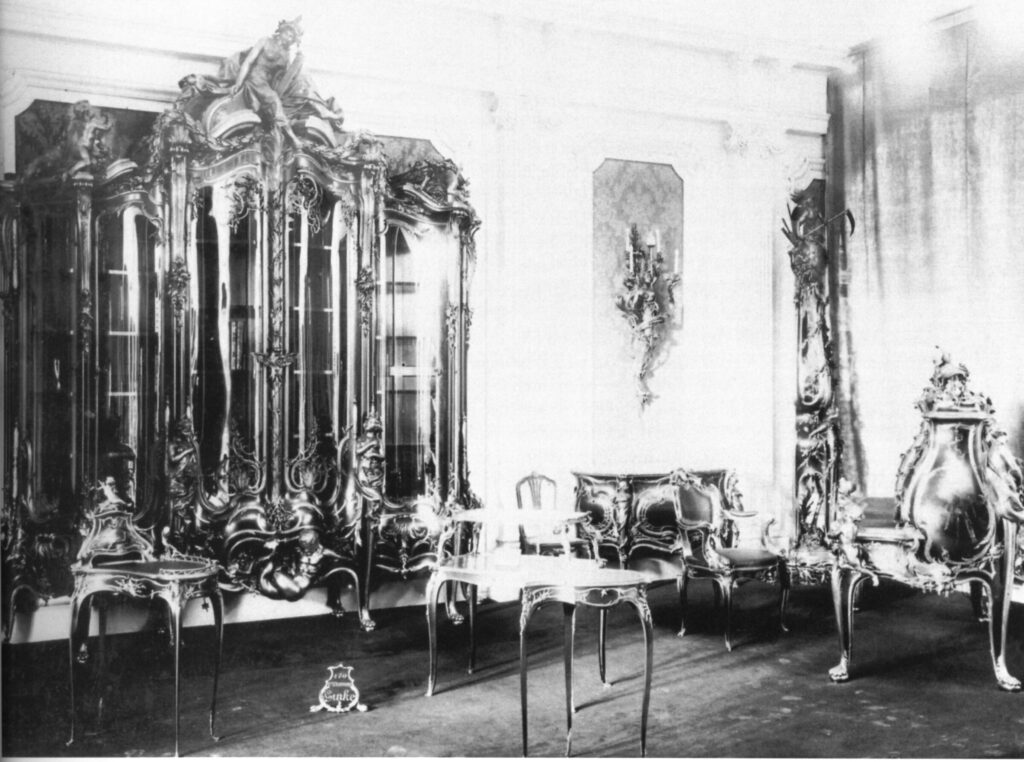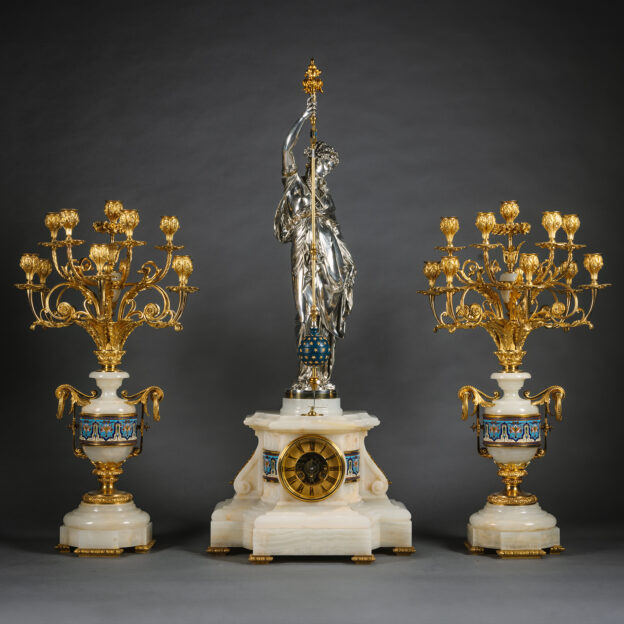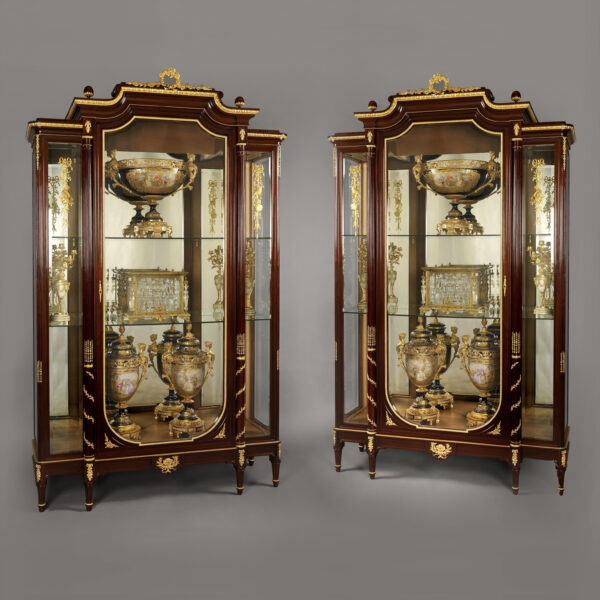Франсуа Линке
‘La Grande Bibliothèque’ – A Highly Important Sculptural Vitrine Cabinet For the Paris Exposition Universelle of 1900
POA
'La Grande Bibliothèque' A Highly Important Sculptural Vitrine Cabinet For the Paris Exposition Universelle of 1900 Designed and...
Размеры
Height: 377 cm (149 in)Width: 325 cm (128 in)
Глубина: 84 см (34 дюйма)
Описание
‘La Grande Bibliothèque’
A Highly Important Sculptural Vitrine Cabinet
For the Paris Exposition Universelle of 1900
Designed and made by François Linke & Léon Messagé. Paris, Circa 1900.
The bronze mounts signed ‘F. Linke’ and stamped ‘LINKE’ to the reverse. Linke Index no: 556.
‘La Grande Bibliothèque’
A Highly Important Sculptural Vitrine Cabinet, for the Paris Exposition Universelle of 1900, designed and made by François Linke and Léon Messagé. The oak carcass with veneers of precious timbers. The whole elaborately applied with sculptural gilt-bronze mounts.

‘La Grande Bibliothèque’ was the centrepiece of François Linke’s gold medal winning stand at the 1900 Paris Exhibition (courtesy Christopher Payne / Linke Archive)
Breathtaking in both scale and conception, this exceptional vitrine cabinet is the chef d’oeuvre of its maker, François Linke (1855-1946). First unveiled at the Paris 1900 Exposition Universelle it embodies the artistic aspirations of the Belle Epoque and the Gilded Age. A definitive example of ‘art furniture’, its extraordinary design is made possible only by phenomenal technical accomplishment in the art of furniture making. Standing at nearly four metres (over twelve feet) high with exceptional three-dimensional gilt-bronze figures, it is as much an exercise in sculpture, as in cabinet making.
Designed with the sculptor Léon Messagé, the whole is adorned with gilt-bronze sculptural figures and rococo inspired ornament. The cornice is centred by a figure of Minerva, holding a tablet bearing the motto ‘De Omni Re Scibili et Quis Busdam Aliis’, (Of all things that can be known and all other things), a fitting enlightenment call to take interest in every aspect of knowledge, be it art or science. Continuing this theme, the figure is flanked by remarkably animated allegories of Geography and Architecture while two enormous espagnolettes representing Art and Literature, frame the central doors, one with an artist’s palette, the other composing poetry. At the base of the central section, the figure of Triton, ‘le Monst l’ignorance’ (the monster of ignorance) as Linke described it, is depicted in Greek form, with two tails. This expressive figure lies beneath a naturalistic tree of life, its trunk extending between the central doors and rising to the progressive heights of the cresting.

‘La Grande Bibliothèque’ illustrated in ‘L’Ameublement à l Exposition de 1900’ and described as: Bibliotheque à 6 portes en bois de violette el de satiné. Les bronzes sont ciselés et dorés au mercure. Le fronton représente Minerve écrivant 1’Histoire; — sur les côtés , des enfants représentant l’Archéologie et la Géographie; — en bas est une voussure où est representé un monstre se débattant, figurant l’Ignorance; — les pieds du milieu représented des figures de femmes: la Musique et la Peinture. Cette Bibliotheque mesure 3m20 de long sur 3m 80 de haut. Prix. . . . 250,000 fr.
‘La Grande Bibliothèque’ dominated Linke’s 1900 exhibition stand and enthralled members of the public and the jury alike. Determined to outshine the competition at the exhibition Linke had set about creating the most ambitious pieces he could envisage, more extravagant than had ever been displayed before. The items he exhibited marked a transition from the historicist interpretation of Louis XV and Louis XVI styles, an interpretation that was the main-stay of his nearest rivals, to something startlingly new and vital in its immediacy.

‘Another view of François Linke’s gold medal winning stand at the 1900 Paris Exhibition (courtesy Christopher Payne / Linke Archive)
Linke’s stand would have appeared refreshingly new to contemporary onlookers, the traditional designs of the Eighteenth Century melting seamlessly into an exuberant naturalism. The ‘Revue’ described Linke’s style as ‘entièrement nouveaux’ and noted ‘This opinion is universally accepted. Linke’s stand is the biggest show in the history of art furniture in the year 1900’ (Revue Artistique & Industrielle, July-August 1900).
Charles Dambreuse describes how the La Grande Bibliothèque was viewed at the 1900 exhibition:
‘First let us talk about the big one, the already famous bookcase; let’s talk about it since everyone is talking about it and everyone wants to have seen it, and it is the highlight of this exhibition’.
Charles Dambreuse, ‘L.Art Industriel à l’Exposition de Meuble de Style – M.F. Linke’, Reveu Artistique & Industreille, Paris, July August 1900. p. 239.
Linke, together with Léon Messagé, developed a new style for the 1900 Exhibition that paid homage to the Louis XV rococo in the fluidity of its approach, but an approach fused with the lively flowing lines of the contemporary and progressive ‘art nouveau’.

‘The original full-scale charcoal drawing for the Grande Bibliothèque by Léon Messagé (courtesy Christopher Payne / Linke Archive)
The Art Journal reported in 1900 on Linke’s stand:
“The work of M. Linke … was an example of what can be done by seeking inspiration amongst the classic examples of Louis XV and XVI without in any great sense copying these great works. M. Linke’s work was original in the true sense of the word, and as such commended itself to the intelligent seeker after the really artistic things of the Exhibition. Wonderful talent was employed in producing the magnificent pieces of furniture displayed….” (‘The Paris Exhibition’, Art Journal 1900, pp. 340-341).

‘La Grande Bibliothèque’ on François Linke’s stand at the 1900 Paris Exhibition (courtesy Christopher Payne / Linke Archive)
The formation of Linke’s distinctive style was made possible by his collaboration with Léon Messagé. The furniture Messagé designed for Linke’s 1900 exhibition stand, with its exuberant allegorical figures cast in high relief recalling the sensual paintings of François Boucher and Jean-Honoré Fragonard, exemplified his ability to seamlessly merge the different media of wood carving, bronze and marquetry into a dynamic unified whole.
After initial sketches, Messagé would produce a three-dimensional wax maquette, which would then be interpreted into a full-scale wooden model by Linke’s craftsmen. At this stage the costly mounts would be modelled in wax and once approved made up to be cast in bronze. Messagé’s original sketches for ‘La Grande Bibliothèque’ survive in the Linke Archive along with the scale wax model standing almost 74 cm (30 inches) high. A sculptural tour de force, Messagé spent 558 hours on the bronzes. His team of modellers consisting of of M. Guillot, M. Dubois and M. Surbled, spent an additional 3,150 hours on modelling. (op. cit. C. Payne, François Linke, p.138-139).

The wax maquette for ‘La Grande Bibliothèque’ (courtesy Christopher Payne / Linke Archive)
EXPOSITION UNIVERSELLE PARIS 1900
The International Exhibition which took place in Paris in 1900 can be considered one of the greatest ever mounted. President Loubert’s words on the opening day, 14th April 1900, must have sounded a note of optimism to all the exhibitors,
“Let this exhibition be an exhibition of harmony, of peace and of progress and if some of the decoration maybe ephemeral, let not its substance be in vain”.

The left bank of the Seine viewed from the Pont Alexandre III, completely redeveloped with the pavilions of many nations built in an extraordinary array of architectural styles for the 1900 exhibition
Paris was transformed, national pavilions lined the Seine, the Grand Palais and the Petit Palais, both in use today, were constructed. The city was bathed in electric illuminations by night and thronged with people by day. 50,860,801 people are recorded to have visited the exhibition. By comparison, the population of France at the time was 41 million.
Linke’s stand was one of the most impressive, standing between the displays of the glass and furniture maker Gallé of Nancy and Schmit of Paris.
In Chefs-d’oeuvre of Applied Art at the Exposition Universelle 1900, Victor Champier provides a summary of the objectives of the exhibition and the artistic aspirations of the age.
“The formula of modern art and of the modern style must, in each one of us, emanate solely from a sense of the dignity, stability, and comfort of modern life. Upon that basis, the logic of our needs will give birth, unsuspected by us, to that modern style which will hereafter most adequately characterize our epoch.” (V. Champier, Exposition Universelle, 1900: The Chefs-d’oeuvre Applied Art, Paris, Vol. 9, p.110).
Illustrated below this concluding epitaph is a colour photograph of the key for La Grande Bibliothèque. The key is a fitting choice, as few other works of art better or more completely, characterise the ambitions of the age. La Grande Bibliothèque, in its scale, style, perfection of construction and sheer ambition, is a definitive work of art of the Belle Epoque.

The unique key for ‘La Grande Bibliothèque’. The bow is formed of a putti wresting open the jaws of a sea monster. The design was created for and only used on the bibliotheque. The key illustrated in V. Champier, Exposition Universelle, 1900: The Chefs-d’oeuvre Applied Art, Paris, Vol. 9, p.110.
Франсуа Линке (1855 - 1946) был самым значительным парижским краснодеревщиком конца XIX - начала XX века и, возможно, самым востребованным краснодеревщиком своего периода.
Он родился в 1855 году в маленькой деревне Панкрац на территории нынешней Чешской Республики. Согласно записям, Линке проходил стажировку у мастера-краснодеревщика Ноймана, затем в 1875 году в возрасте 20 лет он приехал в Париж, где жил до самой смерти в 1946 году.
Известно, что зарождающиеся мастерские Линке активно работали в Париже на Фобур Сент-Антуан уже в 1881 году, и в это время он поставлял мебель для других более известных производителей, таких как Янсен и Кригер.
Качество мастерства Линке было непревзойденным среди его современников и достигло своего пика на его впечатляющем стенде на Всемирной выставке в Париже в 1900 году, где его Гранд Бюро получило золотую медаль. Он поставил на кон свое состояние и репутацию, представив на выставке несколько захватывающих дух предметов мебели со скульптурными креплениями самого исключительного качества и пропорций. Его авантюра сработала, и репутация была настолько прочной, что Linke оставался ведущим мебельным домом в Париже вплоть до Второй мировой войны.
Как писал журнал "Арт Джорнал" в 1900 году о стенде Линке:
"Работа М. Линке ... была примером того, что можно сделать, если искать вдохновение среди классических образцов Людовика XV и XVI, не копируя в каком-либо смысле эти великие произведения. Работа М. Линке была оригинальной в истинном смысле этого слова, и как таковая, она понравилась умному искателю действительно художественных вещей выставки. Замечательный талант был использован при изготовлении великолепных предметов мебели, представленных на выставке....'.
Формирование характерного стиля Линке стало возможным благодаря его сотрудничеству со скульптором Леоном Мессаже. Вместе Линке и Мессаже разработали мебель для выставочного стенда Линке в 1900 году, украшенную аллегорическими фигурами, отлитыми в высоком рельефе, что стало примером способности Линке органично объединять различные средства резьбы по дереву, бронзы и маркетри в динамичное единое целое.
Сегодня Линке наиболее известен благодаря исключительно высокому качеству своих работ, а также своему индивидуализму и изобретательности. Все его работы имеют самые тонкие, самые пышные крепления, очень часто применяемые к сравнительно простым тушам. Технический блеск его работ и художественные изменения, которые они представляли, никогда не будут повторены.
Библиография:
Пейн, Кристофер. Франсуа Линке, (1855 - 1946), Belle Époque французской мебели, Клуб коллекционеров антиквариата, (Вудбридж, Великобритания), 2003.
Мейер, Джонатан. Великие выставки - Лондон, Нью-Йорк, Париж, Филадельфия, 1851-1900, Клуб коллекционеров антиквариата, (Вудбридж, Великобритания), 2006; стр. 298 - 300.
Ledoux - Lebard, Denise. Les Ébénistes du XIXe siècle, Les Editions de l'Amateur, (Paris), 1984; pp. 439-43.
Revue Artistique & Industrielle, (Париж), июль-август 1900 года.
Корал Томсен, Д. (ред.), Парижская выставка 1900 года, Художественный журнал, 1901; стр. 341.
Christopher Payne notes with reference to the records left by François Linke that only three examples of La Grande Bibliothèque were made:
1) The first was made for the 1900 Exposition Universelle and sold to Solomon Barnato “Solly” Joel (1865 –1931), a London based financier who made is fortune in the diamond mines of South Africa.
2) The second was made in 1904 and sold in 1905 to Joseph Raphael De Lamar (1843 – 1918), a Dutchman by birth who became a prominent mine owner and financier in the United States and Canada.
3) The third was made in 1909 and sold in 1912 to Antonio Devoto (1833 – 1916), an Italian émigré to Argentina who became one of the richest men in South America.
The present Grande Bibliothèque is one of two examples to have survived, the other is in a private collection. The third was tragically broken up and only parts of it are known to have survived.
La Décoration et l’ameublement à l’Exposition de 1900, v. 1, by Armand Guèrinet, Paris, 1900, page p. 8, pl. 1
The Art Journal, ‘The Paris Exhibition’, London, Part 1. May 1900, pp. 340-341.
Charles Dambreuse, ‘L.Art Industriel à l’Exposition de Meuble de Style – M.F. Linke’, Reveu Artistique & Industreille, Paris, July August 1900. p. 237-248.
Rapport du Jury International. Exposition universelle international de 1900 à Paris, Paris, 1902 Group XII, Classe 69, p.32.
Exposition internationale universelle de 1900. Catalogue général official, Tome quatorzième. Groupe XII. Décoration et mobilier des édifices publics et des habitations. Classe 69. Meubles à bon marché et meubles de luxe: Paris, Lemercier, 1900. p. 12: No. 58 Linke (François), à Paris, rue du Faubourg-SaintAntoine, 170. – Grande bibliothèque, Grand bureau. Fauteuil de bureau. Deux commodes. Deux bras de lumière. Un régulateur. Un grand bahut. Petits meubles. Fabricant de meubles et bronzes. PL. 1. – C.4.
Christopher Payne, François Linke 1855-1946, The Belle Époque of French
Furniture, Antique Collector’s Club, 2003. pp. 120-123, 138-140
Denise Ledoux-Lebard, Le Mobilier Français du XIXe Siècle, Paris, 2010, p. 435-444.
Camille Mestdagh, L’Ameublement d’art Français 1850-1900, Les Editions de l’Amateur, Paris, 2010 p.189-199.
ChristopherPayne, Paris Furniture: The Luxury Market of the 19th Century, Editions Monelle Hayot (Saint-Remy-en-l’Eau), 2018; pp. 442-443.



















 Печать
Печать


